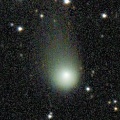
|
Now it is bright as 9.2 mag (June 7, Toshihiko Ikemura, Hirohisa Sato). The brightness evolution is slower than originally expected. It is expected to be observable at 7.5-8 mag for a long time from 2022 to 2023. In the Northern Hemisphere, it stays observable in good condition until autumn. However, it is not observable at the high light from autumn to 2023 summer. In the Southern Hemisphere, it stays observable in good condition for a long time.
Date(TT) R.A. (2000) Decl. Delta r Elong. m1 Best Time(A, h)
June 11 18 5.76 7 41.1 2.040 2.943 146 9.1 0:51 (180, 47)
June 18 17 52.72 5 59.5 1.953 2.881 150 8.9 0:11 (180, 49)
|
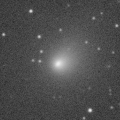
|
Now it is very bright as 9.3 mag (June 5, Chris Wyatt). It stays bright as 9-10 mag from spring to summer. In the Southen Hemisphere, it stays observable in good condition for a long time after this. In the Northern Hemisphere, it is not observable until November when it fades down to 14 mag.
Date(TT) R.A. (2000) Decl. Delta r Elong. m1 Best Time(A, h)
June 11 6 16.74 -79 4.7 1.256 1.777 102 9.4 18:25 ( 14, 36)
June 18 7 51.11 -72 7.2 1.327 1.779 97 9.5 18:25 ( 22, 41)
|
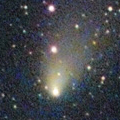
|
Now it is bright as 11.4 mag (May 28, Osamu Miyazaki). It is expected to brighten up to 9-10 mag in summer. But it is not observable around the high light. In the Northern Hemisphere, it is observable only until June. In the Souther Hemisphere, it is not observable until October.
Date(TT) R.A. (2000) Decl. Delta r Elong. m1 Best Time(A, h)
June 11 7 13.20 49 57.4 2.036 1.344 35 10.8 18:25 (142,-13)
June 18 7 44.73 46 2.2 2.006 1.282 33 10.6 18:25 (140,-10)
|

|
Now it is 10.1 mag (May 28, Osamu Miyazaki). In the Northern Hemisphere, it is already unobservable. In the Southern Hemisphere, it becomes unobservable temporarily from July to August.
Date(TT) R.A. (2000) Decl. Delta r Elong. m1 Best Time(A, h)
June 11 7 42.79 7 40.3 4.555 3.814 38 11.0 18:25 (115, 19)
June 18 7 50.05 6 43.7 4.632 3.837 34 11.1 18:25 (110, 16)
|
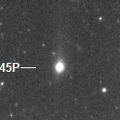
|
Now it is 9.8 mag (June 9, Martin Masek). It is brighter than originally predicted by 3 mag. It brightened up to 6.7 mag in early May (May 10, Mike Olason). Now it is fading rapidly. The condition is very bad in this apparition. It is observable only in the extremely low sky from mid May to mid July in the Northern Hemisphere, or from early June to early August in the Southern Hemisphere.
Date(TT) R.A. (2000) Decl. Delta r Elong. m1 Best Time(A, h)
June 11 7 41.36 23 38.5 1.704 1.023 33 11.2 18:25 (127, 9)
June 18 8 15.80 22 16.8 1.793 1.120 34 12.2 18:25 (127, 11)
|
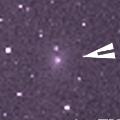
|
Now it is 12.0 mag (June 1, Katsumi Yoshimoto). It will be fading gradually after this. It will be getting higher after this also in the Northern Hemisphere.
Date(TT) R.A. (2000) Decl. Delta r Elong. m1 Best Time(A, h)
June 11 0 27.35 0 12.0 1.768 1.770 73 11.7 5:33 (218, 48)
June 18 0 39.92 1 11.2 1.739 1.803 76 11.9 5:36 (212, 49)
|
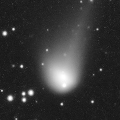
|
Now it is bright as 12.2 mag (June 5, Chris Wyatt). It stays observable at 11-12 mag until July.
Date(TT) R.A. (2000) Decl. Delta r Elong. m1 Best Time(A, h)
June 11 11 52.59 -7 15.8 3.924 4.242 101 11.8 18:35 (180, 62)
June 18 11 56.12 -6 24.5 4.029 4.243 95 11.8 18:25 (172, 61)
|

|
Now it is 13.6 mag (May 26, Jose Guilherme de S. Aguiar). It will brighten up to 12.5 mag in summer. In the Southern Hemisphere, it stays observable in excellent condition for a long time. In the Northern Hemisphere, it is not observable until August.
Date(TT) R.A. (2000) Decl. Delta r Elong. m1 Best Time(A, h)
June 11 21 35.47 -62 37.6 2.454 3.111 121 12.9 4:21 ( 0, 63)
June 18 21 5.63 -63 45.1 2.359 3.090 127 12.8 3:24 ( 0, 61)
|
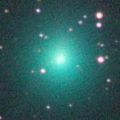
|
It brightened very rapidly up to 9.3 mag in March (Mar. 24, Michael Jager). In the Southern Hemisphere, it is appearing in the morning sky. Now it is very bright as 9.8 mag (June 5, Giuseppe Pappa). It stays observable in good condition after this. In the Northern Hemisphere, it will never be observable again.
Date(TT) R.A. (2000) Decl. Delta r Elong. m1 Best Time(A, h)
June 11 3 7.27 -7 25.4 2.021 1.466 43 12.8 5:33 (261, 25)
June 18 3 18.75 -11 21.2 1.994 1.546 49 13.3 5:36 (262, 31)
|
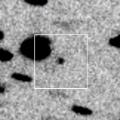
|
Now it is 13.0 mag (May 27, Thomas Lehmann). It stays 12-13 mag for a while. It is observable in excellent condition in the Southern Hemisphere. It locates somewhat low in the Northern Hemisphere.
Date(TT) R.A. (2000) Decl. Delta r Elong. m1 Best Time(A, h)
June 11 22 52.26 -20 14.1 1.287 1.808 102 13.0 5:33 (182, 75)
June 18 23 0.23 -20 31.2 1.258 1.842 107 13.1 5:17 (180, 75)
|

|
Now it is very bright as 13.8 mag (May 31, Thomas Lehmann). It will brighten rapidly, and it will brighten up to 12 mag from June to July. It stays observable in the morning sky until June.
Date(TT) R.A. (2000) Decl. Delta r Elong. m1 Best Time(A, h)
June 11 2 1.67 16 34.2 1.054 0.807 45 14.1 5:33 (230, 21)
June 18 2 51.74 18 30.7 1.085 0.730 40 13.2 5:36 (232, 17)
|

|
Now it is 13.2 mag (June 5, Chris Wyatt). It stays observable at 13-14 mag for a while.
Date(TT) R.A. (2000) Decl. Delta r Elong. m1 Best Time(A, h)
June 11 19 3.11 -30 22.1 2.092 3.043 154 13.3 1:48 (180, 85)
June 18 18 58.90 -30 50.8 2.059 3.041 161 13.3 1:16 (180, 86)
|
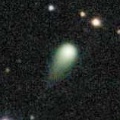
|
Now it is 13.6 mag (June 2, Thomas Lehmann). It is expected to brighten up to 10 mag in 2023. In the Northern Hemisphere, it stays observable in good condition until 2023 autumn. In the Southern Hemipshere, it stays unobservable until 2023 summer.
Date(TT) R.A. (2000) Decl. Delta r Elong. m1 Best Time(A, h)
June 11 9 53.27 57 21.1 4.608 4.189 59 13.5 18:25 (166, -5)
June 18 9 52.13 56 39.3 4.625 4.132 55 13.5 18:25 (162, -6)
|
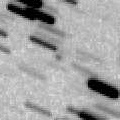
|
It is expected to brighten up to 13.5 mag in early summer. In the Southern Hemisphere, it is appearing in the morning sky. It stays observable in good condition after this. In the Northern Hemisphere, it is not observable at all.
Date(TT) R.A. (2000) Decl. Delta r Elong. m1 Best Time(A, h)
June 11 3 53.27 -32 36.3 1.418 1.249 59 13.7 5:33 (291, 29)
June 18 4 26.98 -38 25.6 1.299 1.257 64 13.6 5:36 (298, 30)
|
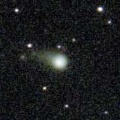
|
Now it is 13.6 mag (June 7, Toshihiko Ikemura, Hirohisa Sato). It is expected to brighten up to 12 mag in 2023. In the Northern Hemisphere, it stays observable in good condition for a long time. In the Southern Hemisphere, it locates extremely low in 2022, but it will be observable in good condition in 2023.
Date(TT) R.A. (2000) Decl. Delta r Elong. m1 Best Time(A, h)
June 11 14 10.11 40 21.6 4.109 4.454 103 13.7 20:51 (180, 15)
June 18 14 0.35 39 2.2 4.153 4.419 98 13.7 20:13 (180, 16)
|
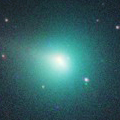
|
It brightened up to 8.8 mag from winter to early spring (Jan. 31, Chris Wyatt). Now it is fading. It has already faded down to 12.1 mag (June 2, Thomas Lehmann). It locates extremely low in the Southern Hemisphere. It will be unobservable in August in the Northern Hemisphere.
Date(TT) R.A. (2000) Decl. Delta r Elong. m1 Best Time(A, h)
June 11 8 40.95 40 27.0 2.509 1.951 46 13.7 18:25 (147, 4)
June 18 9 1.86 39 19.7 2.598 2.003 44 14.0 18:25 (145, 4)
|
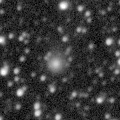
|
Now it is 13.7 mag (June 3, Toshihiko Ikemura, Hirohisa Sato). It is expected to brighten up to 11 mag in 2023. In the Northern Hemisphere, it stays observable in good condition until November. But it becomes unobservable after that. In the Southern Hemisphere, it stays observable in good condition after this.
Date(TT) R.A. (2000) Decl. Delta r Elong. m1 Best Time(A, h)
June 11 18 29.90 17 38.8 3.613 4.395 135 13.9 1:15 (180, 37)
June 18 18 22.45 16 53.4 3.536 4.350 138 13.8 0:40 (180, 38)
|
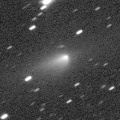
|
Now it is 13.6 mag (May 31, Toshihiko Ikemura, Hirohisa Sato). It is observable at 13 mag in good condition until early summer.
Date(TT) R.A. (2000) Decl. Delta r Elong. m1 Best Time(A, h)
June 11 10 30.02 10 41.3 2.236 2.212 75 13.9 18:25 (156, 41)
June 18 10 40.74 9 26.6 2.303 2.206 71 13.9 18:25 (150, 41)
|
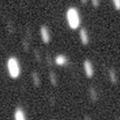
|
Now it is 13.8 mag (June 18, Bob King). It will approach to Earth down to 0.29 a.u. in 2023 February, and it is expected to brighten up to 5 mag. In the Northern Hemisphere, it stays observable in excellent condition. In the Southern Hemisphere, it becomes unobservable from late September to early February.
Date(TT) R.A. (2000) Decl. Delta r Elong. m1 Best Time(A, h)
June 11 19 41.42 25 41.3 2.584 3.212 119 14.1 2:26 (180, 29)
June 18 19 29.48 27 55.9 2.466 3.135 122 13.9 1:47 (180, 27)
|

|
Now it is not observable. It will be observable again in August.
Date(TT) R.A. (2000) Decl. Delta r Elong. m1 Best Time(A, h)
June 11 5 33.05 29 14.4 6.999 5.994 7 14.1 18:25 (114,-18)
June 18 5 39.34 29 14.9 7.005 5.996 5 14.1 5:36 (248,-20)
|
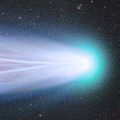
|
It brightened up to 3 mag from mid December to late December. Now it is fading. It has already faded down to 13.4 mag (May 28, Thomas Lehmann). It is observable in good condition in the Southern Hemisphere. It is getting observable again also in the Northern Hemisphere.
Date(TT) R.A. (2000) Decl. Delta r Elong. m1 Best Time(A, h)
June 11 17 41.01 -36 37.9 1.747 2.741 165 14.1 0:27 ( 0, 88)
June 18 17 17.44 -35 2.2 1.832 2.831 166 14.3 23:29 (180, 90)
|
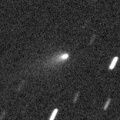
|
Now it is 15.1 mag (May 30, Michael Jager). It is expected to brighten up to 11-12 mag from summer to autumn. It stays observable in good condition in the Southern Hemisphere. In the Northern Hemisphere, it becomes extremely low from August to September.
Date(TT) R.A. (2000) Decl. Delta r Elong. m1 Best Time(A, h)
June 11 10 21.91 20 32.1 1.389 1.418 70 14.5 18:25 (158, 31)
June 18 10 33.98 18 28.8 1.377 1.356 67 14.2 18:25 (153, 32)
|

|
Now it is 15.0 mag (May 26, ATLAS South Africa). It was expected to brighten up to 13 mag in spring. But actually, it is fainter than originally expected. In the Southern Hemisphere, it stays observable in good condition for a long time. In the Northern Hemisphere, it is not observable until autumn.
Date(TT) R.A. (2000) Decl. Delta r Elong. m1 Best Time(A, h)
June 11 6 33.11 -41 30.8 3.387 3.133 67 14.8 18:25 ( 58, 31)
June 18 6 35.21 -40 37.4 3.422 3.133 65 14.8 18:25 ( 57, 26)
|

|
Now it is 15.8 mag (May 28, Thomas Lehmann). It stays at 15-16 mag for a long time. In the Southern Hemisphere, it stays observable in excellent condition for a long time. In the Northern Hemiphere, it locates extremely low in spring.
Date(TT) R.A. (2000) Decl. Delta r Elong. m1 Best Time(A, h)
June 11 15 26.67 -50 53.1 4.405 5.270 145 14.9 22:07 ( 0, 74)
June 18 15 14.94 -50 53.1 4.467 5.287 140 15.0 21:28 ( 0, 74)
|

|
Now it is not observable. It will appear in the morning sky in September in the Northern Hemisphere, or in November in the Southern Hemisphere. It will brighten up to 11.5 mag in winter
Date(TT) R.A. (2000) Decl. Delta r Elong. m1 Best Time(A, h)
June 11 5 54.37 21 51.9 3.350 2.352 9 15.2 18:25 (110,-10)
June 18 6 8.88 21 55.6 3.320 2.311 5 15.1 18:25 (108,-13)
|

|
It brightened up to 12.3 mag from spring to summer in 2021 (June 15, 2021, Marco Goiato). Now it is fading. It has already faded down to 15.4 mag (June 2, Thomas Lehmann).
Date(TT) R.A. (2000) Decl. Delta r Elong. m1 Best Time(A, h)
June 11 12 5.95 31 44.2 4.976 5.043 87 15.8 18:48 (180, 23)
June 18 12 3.29 31 33.0 5.133 5.087 81 15.9 18:25 (178, 24)
|
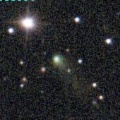
|
Now it is 15.9 mag (June 3, Toshihiko Ikemura, Hirohisa Sato). It stays observable at 16 mag from 2021 to 2022. It locates low in the Southern Hemisphere.
Date(TT) R.A. (2000) Decl. Delta r Elong. m1 Best Time(A, h)
June 11 15 38.46 42 50.5 4.664 5.108 110 16.1 22:19 (180, 12)
June 18 15 34.26 43 6.6 4.738 5.129 107 16.1 21:47 (180, 12)
|
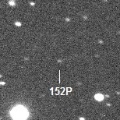
|
Now it is 17.4 mag (May 31, D. De Martin, C. W. Hergenrother). It will brighten up to 16 mag from spring to summer. It locates somewhat low in the Northern Hemisphere.
Date(TT) R.A. (2000) Decl. Delta r Elong. m1 Best Time(A, h)
June 11 19 57.44 -24 1.9 2.327 3.197 142 16.2 2:42 (180, 79)
June 18 19 54.91 -24 32.5 2.284 3.206 150 16.1 2:12 (180, 79)
|
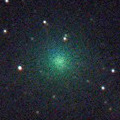
|
It was expected to brighten up to 4 mag, but it faded rapidly around the perihelion passage. It has already faded down to 16.0 mag (June 2, Thomas Lehmann). It stays observable in good condition after this while the comet will be fading. In the Southern Hemisphere, it is not observable until August.
Date(TT) R.A. (2000) Decl. Delta r Elong. m1 Best Time(A, h)
June 11 13 31.16 72 42.5 1.045 1.286 77 16.4 20:15 (180,-17)
June 18 14 2.16 67 36.6 1.173 1.416 80 17.2 20:17 (180,-12)
|
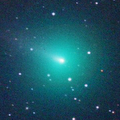
|
It brightened very rapidly up to 9.2 mag in winter (Jan. 31, Chris Wyatt). Now it is fading. It has already faded down to 15.5 mag (May 28, Ken-ichi Kadota). It will be fainter than 18 mag in July.
Date(TT) R.A. (2000) Decl. Delta r Elong. m1 Best Time(A, h)
June 11 10 3.03 9 2.6 2.201 2.083 69 16.5 18:25 (147, 40)
June 18 10 16.52 8 2.7 2.330 2.141 66 16.9 18:25 (142, 39)
|

|
Now it is 16.9 mag (June 6, ATLAS-HKO, Haleakala). It brightened up to 14 mag from 2020 to 2021. Now it is fading slowly. It is observable at 16.5-17 mag in 2022.
Date(TT) R.A. (2000) Decl. Delta r Elong. m1 Best Time(A, h)
June 11 0 31.21 -13 44.1 3.757 3.694 78 16.6 5:33 (233, 59)
June 18 0 36.25 -13 39.8 3.679 3.712 83 16.6 5:36 (224, 62)
|

|
It brightened up to 14 mag in 2021. Now it is fading. It has already faded down to 16.2 mag (June 1, Ken-ichi Kadota). It is observable at 16-17 mag in 2022.
Date(TT) R.A. (2000) Decl. Delta r Elong. m1 Best Time(A, h)
June 11 0 11.16 8 10.6 5.813 5.620 74 16.6 5:33 (208, 43)
June 18 0 12.39 8 58.9 5.740 5.655 80 16.6 5:36 (198, 44)
|

|
Now it is 17.8 mag (June 3, Catalina Sky Survey). It is expected to brighten up to 15 mag in autumn, and it will be observable in good condition. But actually, it is fainter than this ephemeris.
Date(TT) R.A. (2000) Decl. Delta r Elong. m1 Best Time(A, h)
June 11 0 5.98 1 20.0 2.349 2.355 77 16.8 5:33 (210, 49)
June 18 0 16.49 2 14.2 2.251 2.334 81 16.6 5:36 (203, 50)
|
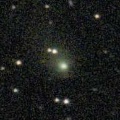
|
It became brighter after the perihelion passage, and it brightened up to 13.4 mag in early 2022 (Jan. 7, Hiroshi Abe). Now it is fading. It has already faded down to 16.0 mag (June 3, Toshihiko Ikemura, Hirohisa Sato). It will be fainter than 18 mag in summer.
Date(TT) R.A. (2000) Decl. Delta r Elong. m1 Best Time(A, h)
June 11 10 23.22 0 17.8 4.225 4.132 77 16.7 18:25 (148, 50)
June 18 10 23.89 -0 31.2 4.381 4.176 71 16.8 18:25 (138, 48)
|
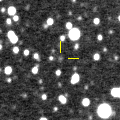
|
Now it is 16.8 mag (June 1, ATLAS South Africa). It will brighten up to 13 mag from 2024 to 2025.
Date(TT) R.A. (2000) Decl. Delta r Elong. m1 Best Time(A, h)
June 11 7 38.00 -24 6.0 8.305 7.822 58 16.7 18:25 ( 84, 36)
June 18 7 42.35 -23 58.7 8.318 7.785 55 16.7 18:25 ( 81, 32)
|
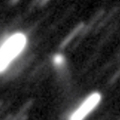
|
Now it is 16.6 mag (June 7, Toshihiko Ikemura, Hirohisa Sato). It was observed at 15 mag in 2021. Now it is fading. It stays observable at 16-17 mag for a while in 2022.
Date(TT) R.A. (2000) Decl. Delta r Elong. m1 Best Time(A, h)
June 11 18 26.26 27 14.3 4.673 5.344 126 16.7 1:11 (180, 28)
June 18 18 21.41 28 11.0 4.685 5.367 127 16.7 0:39 (180, 27)
|

|
It brightened up to 14.2 mag in 2021 summer (July 18, 2021, Taras Prystavski). Now it is fading. It has already faded down to 16.2 mag (Jan. 27, SONEAR Observatory, Oliveira). In the Southern Hemisphere, it stays observable in good condition for a long time. In the Northern Hemisphere, it is not observable until July.
Date(TT) R.A. (2000) Decl. Delta r Elong. m1 Best Time(A, h)
June 11 2 3.37 -25 39.1 5.060 4.762 67 16.8 5:33 (271, 48)
June 18 2 7.56 -25 22.2 5.022 4.801 71 16.8 5:36 (267, 53)
|

|
It is expected to brighten very rapidly up to 11-12 mag in winter, and it will be observable in excellent condition.
Date(TT) R.A. (2000) Decl. Delta r Elong. m1 Best Time(A, h)
June 11 2 53.32 9 16.2 3.009 2.277 36 17.0 5:33 (245, 17)
June 18 3 7.53 10 5.6 2.932 2.247 39 16.9 5:36 (241, 20)
|
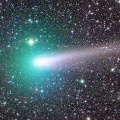
|
It brightened up to 8.5 mag from autumn to winter in 2021 (Dec. 2, Toshihiko Ikemura, Hirohisa Sato). Now it is fading. It has already faded down to 16.5 mag (May 26, Catalina Sky Survey). It stays observable in good condition for a long time.
Date(TT) R.A. (2000) Decl. Delta r Elong. m1 Best Time(A, h)
June 11 10 9.09 14 11.4 2.813 2.634 69 16.9 18:25 (152, 36)
June 18 10 18.30 13 11.8 2.948 2.685 65 17.1 18:25 (146, 35)
|

|
Now it is 16.4 mag (June 6, ATLAS-MLO, Mauna Loa). Appearing in the morning sky. It will be observable at 16.5 mag in good condition from summer to autumn.
Date(TT) R.A. (2000) Decl. Delta r Elong. m1 Best Time(A, h)
June 11 1 27.89 14 21.4 2.573 2.145 54 17.0 5:33 (224, 28)
June 18 1 40.89 15 46.0 2.523 2.155 57 16.9 5:36 (220, 29)
|
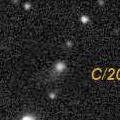
|
Now it is 16.8 mag (May 31, Toshihiko Ikemura, Hirohisa Sato). It stays observable at 17-18 mag for a long time until 2024.
Date(TT) R.A. (2000) Decl. Delta r Elong. m1 Best Time(A, h)
June 11 13 29.43 4 12.0 8.289 8.819 118 17.0 20:11 (180, 51)
June 18 13 26.54 4 23.8 8.398 8.819 111 17.0 19:40 (180, 51)
|

|
It will brighten up to 16.5 mag in July. In 2022, it stays observable for a long time.
Date(TT) R.A. (2000) Decl. Delta r Elong. m1 Best Time(A, h)
June 11 22 3.58 -9 50.3 0.640 1.375 110 17.4 4:47 (180, 65)
June 18 22 31.62 -6 27.7 0.567 1.317 109 17.1 4:47 (180, 61)
|
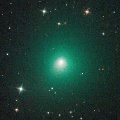
|
It brightened up to 9.5 mag in early summer in 2021 (June 27, Marco Goiato). Now it is fading. It has already faded down to 17.0 mag (May 26, ATLAS Chile). In the Northern Hemisphere, it stays extremely low.
Date(TT) R.A. (2000) Decl. Delta r Elong. m1 Best Time(A, h)
June 11 23 19.82 -33 21.0 3.876 4.200 101 17.1 5:33 (256, 83)
June 18 23 22.22 -34 2.9 3.846 4.259 107 17.2 5:36 (208, 89)
|
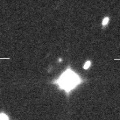
|
Now it is 17.6 mag (June 2, ATLAS-HKO, Haleakala). It is expected to brighten up to 12.5 mag in winter. It will become unobservable temporarily at 17 mag in July. In the Northern Hemisphere, it will become observable again in October. Then it stays observable in good condition after that. In the Southern Hemisphere, it is not observable at the high light.
Date(TT) R.A. (2000) Decl. Delta r Elong. m1 Best Time(A, h)
June 11 10 27.60 7 46.6 3.591 3.487 75 17.2 18:25 (154, 44)
June 18 10 28.96 8 44.3 3.648 3.422 69 17.2 18:25 (146, 40)
|

|
Now it is 17.2 mag (June 3, B. Haeusler). Fading slowly. In the Northern Hemisphere, it stays observable in good condition for a long time. In the Southern Hemisphere, it is not observable after this.
Date(TT) R.A. (2000) Decl. Delta r Elong. m1 Best Time(A, h)
June 11 18 45.67 67 9.7 9.186 9.211 88 17.2 1:29 (180,-12)
June 18 18 37.02 67 41.1 9.195 9.223 88 17.2 0:53 (180,-13)
|
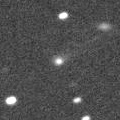
|
Now it is 16.8 mag (June 3, Toshihiko Ikemura, Hirohisa Sato). It stays 17 mag for a while.
Date(TT) R.A. (2000) Decl. Delta r Elong. m1 Best Time(A, h)
June 11 13 8.03 -7 20.8 4.139 4.711 118 17.2 19:50 (180, 62)
June 18 13 8.39 -7 27.0 4.235 4.713 112 17.3 19:23 (180, 63)
|
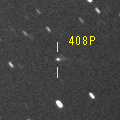
|
Appearing in the morning sky. It will be observable at 16 mag in excellent condition from autumn to winter.
Date(TT) R.A. (2000) Decl. Delta r Elong. m1 Best Time(A, h)
June 11 2 56.56 9 29.5 4.284 3.511 35 17.3 5:33 (245, 17)
June 18 3 5.58 9 44.5 4.219 3.506 40 17.2 5:36 (241, 20)
|

|
Now it is 17.9 mag (June 1, iTelescope Observatory, Siding Spring). It stays 17 mag for a long time from 2021 to 2022. In the Southern Hemisphere, it stays observable in good condition for a long time. It is not observable in the Northern Hemisphere.
Date(TT) R.A. (2000) Decl. Delta r Elong. m1 Best Time(A, h)
June 11 6 53.65 -41 7.5 5.850 5.552 68 17.4 18:25 ( 60, 34)
June 18 6 57.09 -41 21.7 5.886 5.566 66 17.5 18:25 ( 58, 30)
|
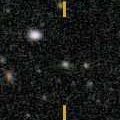
|
Now it is 17.8 mag (June 3, Toshihiko Ikemura, Hirohisa Sato). It is observable at 17 mag from spring to summer. In the Northern Hemisphere, it becomes low in summer.
Date(TT) R.A. (2000) Decl. Delta r Elong. m1 Best Time(A, h)
June 11 11 30.89 14 46.3 1.847 2.072 87 17.5 18:25 (176, 40)
June 18 11 37.88 12 16.5 1.908 2.060 83 17.5 18:25 (169, 42)
|
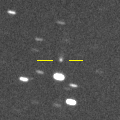
|
Now it is 17.6 mag (May 3, ATLAS Chile). It will brighten up to 16 mag in 2023. In the Southern Hemisphere, it stays observable in good condition for a long time. In the Northern Hemisphere, it will be unobservable soon.
Date(TT) R.A. (2000) Decl. Delta r Elong. m1 Best Time(A, h)
June 11 9 44.80 -17 30.6 4.071 3.973 77 17.5 18:25 (116, 59)
June 18 9 48.67 -17 56.6 4.121 3.936 72 17.5 18:25 (109, 54)
|
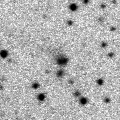
|
Now it is 17.5 mag (June 1, A. Diepvens). It started fading before the perihelion passage. It was predicted to stay at 16 mag for a long time. But actually, it will be fainter than 18 mag in autumn. In the Northern Hemisphere, it stays observable in good condition for a long time. In the Southern Hemisphere, it is not observable until 2023.
Date(TT) R.A. (2000) Decl. Delta r Elong. m1 Best Time(A, h)
June 11 23 24.88 82 39.2 4.058 3.776 66 17.6 5:33 (181,-28)
June 18 22 43.54 83 38.0 4.037 3.783 68 17.6 5:00 (180,-29)
|
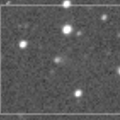
|
It was observed at 17 mag in 2021. It is observable at 17-18 mag also in 2022. It will be observable soon also in the Northern Hemisphere.
Date(TT) R.A. (2000) Decl. Delta r Elong. m1 Best Time(A, h)
June 11 2 14.72 0 26.6 3.839 3.269 49 17.6 5:33 (245, 30)
June 18 2 21.49 1 33.1 3.781 3.284 53 17.6 5:36 (239, 34)
|
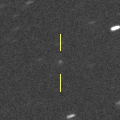
|
Now it is 18.4 mag (June 1, J.-G. Bosch, F. Kugel). The condition is bad in this apparition. It will brighten up to 13 mag in winter. But it is not observable at the high light. Before the perihelion passage, it is observable only until August when it brightens up to 17 mag.
Date(TT) R.A. (2000) Decl. Delta r Elong. m1 Best Time(A, h)
June 11 10 20.38 19 7.7 2.655 2.504 70 17.8 18:25 (157, 33)
June 18 10 28.08 18 0.8 2.700 2.466 65 17.8 18:25 (151, 32)
|
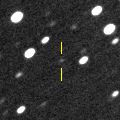
|
Now it is 17.9 mag (June 5, ATLAS South Africa). It is expected to brighten up to 12-13 mag from 2024 to 2025.
Date(TT) R.A. (2000) Decl. Delta r Elong. m1 Best Time(A, h)
June 11 9 53.06 -20 49.0 7.796 7.695 80 17.8 18:25 (113, 62)
June 18 9 53.78 -20 12.9 7.855 7.650 74 17.8 18:25 (107, 56)
|
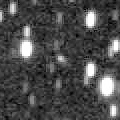
|
Now it is 17.7 mag (May 26, iTelescope Observatory, Mayhill). It stayed 17.5 mag for a long time in 2021. It will be fading slowly after this. In the Northern Hemisphere, it is observable in good condition. It is not observable in the Southern Hemisphere.
Date(TT) R.A. (2000) Decl. Delta r Elong. m1 Best Time(A, h)
June 11 11 33.92 61 22.2 7.586 7.337 72 17.8 18:25 (179, -6)
June 18 11 35.47 60 11.7 7.661 7.354 68 17.9 18:25 (176, -5)
|
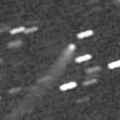
|
It brightened up to 14.2 mag from summer to autumn in 2021 (Sept. 3, C. S. Morris). Now it is 17.6 mag (June 1, Catalina Sky Survey). Fading slowly. In the Northern Hemisphere, it is observable in good condition. It is not observable in the Southern Hemisphere.
Date(TT) R.A. (2000) Decl. Delta r Elong. m1 Best Time(A, h)
June 11 14 26.54 68 51.0 7.217 7.167 83 17.8 21:06 (180,-14)
June 18 14 15.75 68 12.8 7.298 7.206 80 17.9 20:28 (180,-13)
|

|
Now it is 17.7 mag (June 3, Toshihiko Ikemura, Hirohisa Sato). It stays 17-18 mag until June.
Date(TT) R.A. (2000) Decl. Delta r Elong. m1 Best Time(A, h)
June 11 19 36.00 -9 19.3 1.259 2.162 143 17.8 2:22 (180, 64)
June 18 19 7.80 -5 37.5 1.266 2.221 153 18.0 1:26 (180, 61)
|
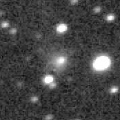
|
Now it is 17.4 mag (June 6, W. Hasubick). It was observed at 16 mag from 2020 to 2021. Now it is fading. It will be fainter than 18 mag in summer.
Date(TT) R.A. (2000) Decl. Delta r Elong. m1 Best Time(A, h)
June 11 22 24.13 14 59.3 6.599 6.772 95 17.9 5:08 (180, 40)
June 18 22 22.16 14 45.8 6.508 6.795 102 17.9 4:39 (180, 40)
|
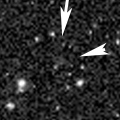
|
Now it is 16.9 mag (May 26, ATLAS South Africa). Very far object. It stays 18 mag for a long time from 2021 to 2026. In the Southern Hemisphere, it stays observable in good condition for a long time. In the Northern Hemisphere, it is not observable at all.
Date(TT) R.A. (2000) Decl. Delta r Elong. m1 Best Time(A, h)
June 11 7 34.88 -62 12.4 10.641 10.683 89 17.9 18:25 ( 34, 43)
June 18 7 37.62 -62 3.7 10.654 10.673 88 17.9 18:25 ( 35, 40)
|

|
Now it is 18.1 mag (June 7, Toshihiko Ikemura, Hirohisa Sato). It was expected to be observable at 16 mag in good condition in spring. But actually, it is fainter than predicted by 2-3 mag.
Date(TT) R.A. (2000) Decl. Delta r Elong. m1 Best Time(A, h)
June 11 21 20.51 1 14.6 0.921 1.640 115 18.5 4:05 (180, 54)
June 18 21 21.05 3 40.3 0.912 1.677 120 18.5 3:38 (180, 51)
|
|
![]()
 117P/Helin-Roman-Alu 1
117P/Helin-Roman-Alu 1 C/2020 V2 ( ZTF )
C/2020 V2 ( ZTF ) C/2021 T2 ( Fuls )
C/2021 T2 ( Fuls ) C/2019 U5 ( PanSTARRS )
C/2019 U5 ( PanSTARRS ) 19P/Borrelly
19P/Borrelly C/2020 K1 ( PanSTARRS )
C/2020 K1 ( PanSTARRS ) 116P/Wild 4
116P/Wild 4 C/2022 E3 ( ZTF )
C/2022 E3 ( ZTF ) 29P/Schwassmann-Wachmann 1
29P/Schwassmann-Wachmann 1 C/2021 A1 ( Leonard )
C/2021 A1 ( Leonard ) 73P/Schwassmann-Wachmann 3
73P/Schwassmann-Wachmann 3 C/2020 Y2 ( ATLAS )
C/2020 Y2 ( ATLAS ) C/2018 U1 ( Lemmon )
C/2018 U1 ( Lemmon ) 81P/Wild 2
81P/Wild 2 C/2020 J1 ( SONEAR )
C/2020 J1 ( SONEAR ) C/2020 H6 ( ATLAS )
C/2020 H6 ( ATLAS ) 152P/Helin-Lawrence
152P/Helin-Lawrence C/2021 O3 ( PanSTARRS )
C/2021 O3 ( PanSTARRS ) 104P/Kowal 2
104P/Kowal 2 246P/NEAT
246P/NEAT C/2020 F5 ( MASTER )
C/2020 F5 ( MASTER ) 61P/Shajn-Schaldach
61P/Shajn-Schaldach C/2020 M5 ( ATLAS )
C/2020 M5 ( ATLAS ) C/2021 G2 ( ATLAS )
C/2021 G2 ( ATLAS ) C/2020 O2 ( Amaral )
C/2020 O2 ( Amaral ) C/2019 F1 ( ATLAS-Africano )
C/2019 F1 ( ATLAS-Africano ) 118P/Shoemaker-Levy 4
118P/Shoemaker-Levy 4 67P/Churyumov-Gerasimenko
67P/Churyumov-Gerasimenko 44P/Reinmuth 2
44P/Reinmuth 2 C/2020 F2 ( ATLAS )
C/2020 F2 ( ATLAS ) 107P/(4015) Wilson-Harrington
107P/(4015) Wilson-Harrington C/2020 T2 ( Palomar )
C/2020 T2 ( Palomar ) C/2022 A2 ( PanSTARRS )
C/2022 A2 ( PanSTARRS ) C/2019 O3 ( Palomar )
C/2019 O3 ( Palomar ) 99P/Kowal 1
99P/Kowal 1 408P/2020 M7 ( Novichonok-Gerke )
408P/2020 M7 ( Novichonok-Gerke ) C/2020 F7 ( Lemmon )
C/2020 F7 ( Lemmon ) 100P/Hartley 1
100P/Hartley 1 C/2021 C5 ( PanSTARRS )
C/2021 C5 ( PanSTARRS ) C/2020 U5 ( PanSTARRS )
C/2020 U5 ( PanSTARRS ) 422P/2021 L1 ( Christensen )
422P/2021 L1 ( Christensen ) 71P/Clark
71P/Clark C/2022 E2 ( ATLAS )
C/2022 E2 ( ATLAS ) C/2020 P3 ( ATLAS )
C/2020 P3 ( ATLAS ) C/2019 K7 ( Smith )
C/2019 K7 ( Smith ) C/2022 J1 ( Maury-Attard )
C/2022 J1 ( Maury-Attard ) C/2019 T3 ( ATLAS )
C/2019 T3 ( ATLAS ) C/2019 E3 ( ATLAS )
C/2019 E3 ( ATLAS ) 325P/Yang-Gao
325P/Yang-Gao![]()




















































